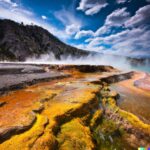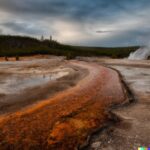Yellowstone National Park is not only known for its stunning natural beauty but also for its impressive geothermal features, including geysers. In this article, we will explore the formation of geysers, the history of geysers in Yellowstone, and the park’s contribution to geyser research. From the conditions required for geysers to form to the lessons learned from studying geysers in Yellowstone, this article will highlight the ongoing importance of the park in advancing our understanding of these fascinating natural phenomena.
The Formation of Geysers
Yellowstone National Park is renowned for its unique geological features, with geysers being one of the most fascinating attractions.
Geysers in Yellowstone are formed through a combination of factors involving the park’s volcanic history and hydrothermal processes. The park sits atop a massive supervolcano, which fuels the intense geothermal activity that gives rise to these natural wonders. Underground reservoirs of hot water are heated by the molten rock beneath the surface, creating the pressure necessary for eruptions. As water seeps deep into the earth, it interacts with hot rocks, dissolving minerals along the way. This process not only contributes to the unique coloration of the geysers but also helps in shaping their intricate formations.
What Are Geysers?
Geysers are hydrothermal features that periodically erupt hot water and steam due to geological processes beneath the earth’s surface.
These unique thermal features are typically found in geologically active regions, where magma heats underground water, causing it to rise and create intense pressure. This pressure builds up until it reaches a critical point, resulting in a sudden release of steam and hot water through a vent, known as an eruption.
The intervals between eruptions can vary, ranging from minutes to days or even years, depending on the specific geyser. Yellowstone National Park in the United States is renowned for its impressive geysers, such as Old Faithful, which erupts at regular intervals.
What Are the Conditions Required for Geysers to Form?
The formation of geysers necessitates specific conditions, including underground water reservoirs, intense heat sources, pressure buildup, and vent structures.
These essential conditions interact in a complex interplay to create the thrilling natural phenomena we know as geysers. Underground water reservoirs, often originating from rainfall and snowmelt, seep deep into the Earth’s crust where they encounter intense heat from magma chambers or volcanic activity. This heat causes the water to reach temperatures well above its boiling point, leading to the accumulation of steam and pressure. As pressure builds up, it seeks release through vent structures, resulting in the iconic eruptions that characterize geysers.
The History of Geysers in Yellowstone
The history of geysers in Yellowstone dates back to the early exploration and preservation efforts that led to the park’s recognition by UNESCO.
Yellowstone, with its vast array of geothermal features, became a focal point for scientists and nature enthusiasts alike due to the unique geological formations showcased by the geysers. The preservation initiatives undertaken by early conservationists paved the way for Yellowstone to be designated as a UNESCO World Heritage Site in recognition of its outstanding universal value. The park’s geysers, including the famous Old Faithful, have attracted visitors for generations, highlighting the importance of balancing tourism with conservation efforts to ensure these natural wonders are enjoyed by future generations.
When Were Geysers First Discovered in Yellowstone?
Geysers in Yellowstone were first officially documented during the scientific expeditions of the 19th century, marking a significant milestone in geological studies.
These expeditions not only unveiled the mesmerizing thermal wonders but also paved the way for further scientific investigations into the unique geothermal features of the park. The pioneering explorations of scientists like Ferdinand Hayden and the Washburn-Langford-Doane Expedition of 1870 played a crucial role in shedding light on the mysterious workings of geysers. The subsequent studies conducted by geologists and geophysicists delved deeper into the underlying mechanisms responsible for the eruption patterns, temperature fluctuations, and mineral composition of these geothermal marvels, enhancing our understanding of Yellowstone’s geological heritage.
How Many Geysers are in Yellowstone?
Yellowstone National Park is home to over 500 geysers, scattered across its diverse geothermal landscapes, making it a hotspot for geyser enthusiasts and researchers.
These unique geothermal features are a result of the park’s underlying volcanic activity, creating a dynamic environment where geysers erupt with impressive force and frequency. With areas like the Upper Geyser Basin, home to iconic geysers like Old Faithful, visitors can witness firsthand the power and beauty of these natural wonders. The distribution of geysers within the park showcases the intricate connection between underground thermal reservoirs and surface manifestations, offering a glimpse into the Earth’s geothermal processes on a grand scale.
Yellowstone’s Contribution to Geyser Research
Yellowstone’s rich geyser diversity has been instrumental in advancing geyser research and attracting scientists from around the globe to study its unique geological formations.
The geothermal activity in Yellowstone National Park provides unparalleled opportunities for researchers to delve into the complexities of hydrothermal systems, offering insights into volcanic processes and geophysical phenomena. By analyzing the chemical composition of geyser waters and monitoring their eruptions, scientists can uncover clues about subsurface magma movements and potential volcanic activity. This ongoing research not only deepens our understanding of Earth’s geology but also aids in predicting natural hazards and safeguarding surrounding ecosystems from potential geological disturbances.
How Has Yellowstone’s Unique Geology Helped in Geyser Research?
Yellowstone’s distinctive geology, characterized by its hydrothermal features and volcanic history, has provided a fertile ground for geyser research endeavors, yielding valuable insights into these geological phenomena.
The unique geological composition of Yellowstone National Park, with its abundance of geothermal landscapes and ancient volcanic activity, offers researchers a natural outdoor laboratory to study the behavior and formation of geysers. The park’s hot springs, geysers, and fumaroles result from the interaction of underground water with molten rock deep beneath the surface, creating a dynamic environment for studying the Earth’s geothermal processes and understanding the forces at play beneath the planet’s crust. This geologic setting supports ongoing scientific investigations that contribute to our knowledge of geyser behavior and the broader field of geothermal science.
What Have Scientists Learned from Studying Geysers in Yellowstone?
Scientists studying geysers in Yellowstone have made significant discoveries regarding the intricate workings of the park’s hydrothermal system, shedding light on the underlying processes driving geyser eruptions.
By closely monitoring the behavior of geysers, researchers have unraveled the dynamic interactions between the underground water sources and geothermal features. These studies have revealed how the timing and intensity of geyser eruptions are influenced by variations in temperature, pressure, and mineral content within the hydrothermal system. The interconnectedness of geysers and hot springs in Yellowstone has provided valuable insights into the broader geologic processes at play beneath the surface, deepening our understanding of hydrothermal activity in this unique ecosystem.
The Role of Yellowstone in Understanding Geysers Worldwide
Yellowstone’s pivotal role in geyser research extends beyond its borders, influencing global conservation efforts and contributing to a deeper understanding of ecosystem health in geothermal regions worldwide.
The unique geothermal features of Yellowstone National Park serve as a natural laboratory for researchers and conservationists studying the intricate connections between geysers, biodiversity, and ecosystem conservation.
By studying the interactions of geothermal activity with plant and animal life, scientists at Yellowstone have been able to develop innovative conservation practices that can be applied to geothermal sites around the world.
This research not only sheds light on the fragility and resilience of ecosystems in geothermal regions but also provides valuable insights into sustainable management strategies for biodiversity conservation.
How Have Discoveries in Yellowstone Been Applied to Other Geyser Sites?
The discoveries made in Yellowstone have served as a blueprint for effective geyser site management and informed scientific studies at other locations grappling with similar geothermal challenges.
Lessons learned from Yellowstone have been instrumental in shaping the management practices and research initiatives at various geyser sites worldwide. The pioneering work carried out in Yellowstone helped establish protocols for monitoring geothermal activity, enhancing safety measures, and conserving these fragile ecosystems. As a result, these principles have been integrated into the management strategies of other geothermal areas, fostering a more sustainable approach to harnessing the scientific value of these natural wonders while preserving their ecological integrity.
What Can Other Geyser Sites Learn from Yellowstone’s Management and Conservation Efforts?
Other geyser sites can glean valuable lessons from Yellowstone’s exemplary management and conservation efforts, leveraging educational resources to enhance their preservation practices and environmental protection measures.
Yellowstone National Park employs a range of strategies to maintain the delicate balance between visitor experience and the preservation of its natural wonders. Through informative signage, guided tours, and interactive exhibits, visitors are educated about the geothermal features and the importance of conservation. The park encourages responsible behavior through Leave No Trace principles and volunteer programs, engaging visitors in hands-on efforts to protect the environment. By integrating education into the visitor experience, Yellowstone fosters a deeper appreciation for the unique ecosystem and instills a sense of stewardship among its guests.
Last Updated on February 8, 2024 by Jon Waraas – Originally Posted: February 8, 2024

I’m Jon Waraas, and I’ve been navigating the online world since 2006. By day, I’m the proud owner of some eCommerce gems, and by night, I’m the voice behind the adventures on Waraas.Com.
My heart, however, belongs to the wild beauty of Yellowstone National Park. I’ve got a collection of websites dedicated to sharing the wonders of this natural masterpiece. Oh, and did I mention? I’m currently building my own cabin inside the ghost town of Gilmore, Idaho – a cabin with tales to tell!
When I’m not immersed in the digital realm, you’ll find me lacing up my boots for a good hike or setting up camp under the star-studded sky.




